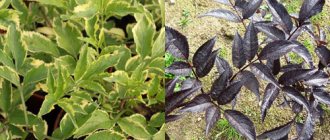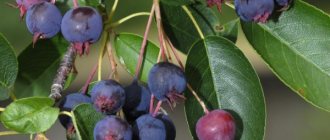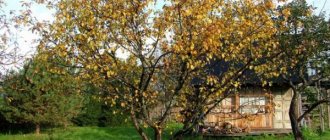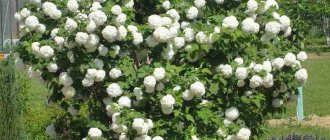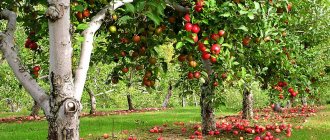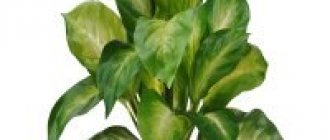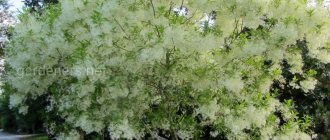Description of viburnum
Viburnum grows in the form of deciduous or evergreen shrubs, sometimes small trees. Most species are shade-tolerant and moisture-loving. Absolutely all species have opposite, sometimes whorled, arrangement of leaves. Red or black fruits are mostly edible. Viburnum is propagated by cuttings, seeds, and layering. Residents of central Russia have the sign of viburnum due to its wide distribution - common viburnum.
In the wild, it can be found in almost every forest - in a clearing, edge, clearing.
Viburnums are very decorative. Most begin to bloom in May, ending the spring riot of flowers with pinkish, white or yellowish inflorescences. Flowering, sometimes stretching for three weeks. All viburnums are excellent honey plants.
Viburnums are also famous for their fruits. The berries acquire color already in August. They look great against the background of a green crown, delight the eye all autumn and decorate the bushes even in winter. In some species the fruits are pinkish-orange or red. Other types of viburnum produce black berries with a blue or bluish tinge. But there is such a viburnum that has fruits of 2 colors: ripe ones are black, and others, unripe ones, are red in color.
Types and varieties of viburnum
Some species of viburnum have decorative forms that differ from their ancestors in special appearance features. The most famous cultivar of viburnum is Buldenezh.
Viburnum red or common
It grows in the forest and forest-steppe zones of almost all of Europe.
Shrub or tree 4 m in height. The trunk of the bush is covered with fissured bark. The leaves of the common viburnum are large, 5-lobed, light green in the spring, simply green in the summer, and reddish in the fall.
Barren white flowers bloom several days earlier than fertile viburnums, decorating the bush for 15 days. The fruits are red, round-shaped drupes with yellow flesh, edible, and look cute against the background of greenery.

Has decorative forms:
Viburnum viburnum 'Nanum' is a dwarf form (1m) with small leaves. Grows from April to early October. Growth is slow. In winter it freezes a little.
Viburnum ordinary 'Roseum' ('Roseum') is the most common, it is also called “Bulde-tender”. The height of the bush is 2 m, the height of the tree is 4 m. The crown of the common viburnum Buldenezh is wide-spreading. The spherical inflorescences consist of sterile flowers, first olive, then white, resembling snowballs.

When blooming, the flowers of the viburnum Buldenezh turn pink. During flowering, which lasts 35 days, the shrub is decorative both in group and single plantings. It looks especially impressive near the water and in standard form.
Viburnum viburnum 'Compactum', the bush is up to 2 m in height. It blooms in June.

Flowers of Viburnum vulgare 'Compactum', marginal white, middle small, bisexual, pinkish or white. The fruits of Viburnum vulgare 'Compactum' are bright red..
Viburnum viburnum 'Aureum'. A compact bush with a height of 2 m. The foliage is yellow and turns green in summer. Her flowers are white. The fruits of Viburnum vulgare 'Aureum' are beautiful red in color. Looks beautiful in light partial shade, especially in sunny, hot summers. It may freeze.
Kalina Sargenta
Under natural conditions, it is widespread in the Far East, Eastern Siberia, Sakhalin, Korea, and Japan. Viburnum Sargent is widespread in the European part of Russia, in Altai, the Urals, where it is found along forest edges, clearings, and among thickets near water.

Viburnum Sargent has a spreading bush and leaves with long petioles and a central vein. Flowering begins at the end of May. Sterile flowers up to 3 cm in diameter; the flowers have purple, sometimes yellow, anthers. In early October, spherical, bright red fruits ripen.
Shade-tolerant, winter-hardy. Viburnum Sargent is a good ornamental shrub, especially spectacular during flowering and fruiting, in solitary plants along the banks of reservoirs.
Kalina Gordovina
It is a well-known viburnum with black fruits, which are also edible. Viburnum gourdovina is widespread in Asia Minor, Central and Southern Europe, and the North Caucasus.
Viburnum viburnum has a completely different appearance compared to red viburnum. The shrub is 5 m high. The crown is compact, dense, 2.5 m in diameter.
Viburnum gordovina is one of the most beautiful ornamental shrubs; it has long been used in landscaping parks and gardens. Undemanding to soil, frost-resistant, shade-tolerant, drought-resistant, retains pink-red leaves and black fruits until winter. Excellent propagation by seeds.
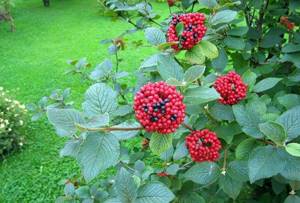
This type of viburnum is one of the most beautiful ornamental shrubs, elegant during flowering, during the period of fruit ripening and in the autumn season with brightly colored foliage. Pairs perfectly with linden and oak.
Viburnum gourdovina has decorative forms: variegated - with yellow-variegated foliage; and wrinkled - with larger inflorescences and more wrinkled leaves.
Viburnum gordovina 'Aureum'. Bush 3 m high, with oval leaves. The leaves are golden on top and silvery-felt underneath.
Viburnum viburnum 'Aureo-variegatum'. The leaves of this viburnum have yellow stripes and spots. Flowering occurs in May and can sometimes bear fruit.
Viburnum black
Grows in the south of Khabarovsk and Primorsky Krai. Grows in coniferous-deciduous forests.
A strongly branching, spreading bush about 3 m in height, sometimes a small tree with an openwork crown, a grayish trunk and light, bare, yellow-gray branches. The leaves are elliptical, acute at the apex, dark green above; yellow-white, inconspicuous flowers are collected in stitch-shaped inflorescences.

The fruits of black viburnum have shiny, black skin and sweet pulp, edible.
Black viburnum is light-loving and demanding on the soil. Tolerates transplantation well. Decorative all season, but especially in autumn.
Protection from pests and diseases: viburnum is often affected by the viburnum bark beetle, which eats all the foliage, leaving only veins. To combat it, you can treat it with 0.2% chlorophos.
Decorative forms of viburnum are best propagated by cuttings. Their rooting rate is very high.
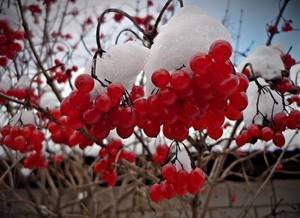
All viburnums are decorative, some have a variety of decorative forms. Viburnums are very impressive against the background of linden, birch, maple, spruce and rowan trees. Viburnums in the garden are not only beautiful, but also useful, medicinal and edible plants.
Red viburnum (Vibúrnum ópulus) is a deciduous shrub of the Viburnum genus.
Kalina Gordovina
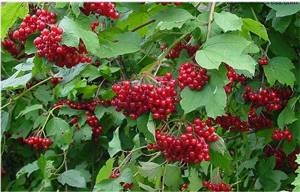
In the photo there are berries of viburnum Gordovina
Viburnum gourd (V. lantana) is a tall shrub with a dense crown, the height of which reaches five meters, its diameter is from 2.5 to 3 meters. Beautiful oval-shaped leaves, strongly wrinkled, very dense to the touch, about 18 cm long. It begins to bloom in June with many corymbose inflorescences having a creamy white color. Flowering lasts 20-25 days. The bush becomes incredibly beautiful when the berries ripen, which are edible and shower it with bright red dots, turning into a rich black color.
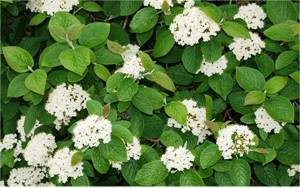
Viburnum Gordovina during the flowering period
This species is one of the most beautiful ornamental plants used for landscaping city parks, boulevards, and squares. It is completely undemanding to soil fertility, resistant to drought, frost-resistant, its leaves are bright pink or red, rich black bunches of berries delight the eye until winter. It is good to combine the pride tree with deciduous trees such as linden or oak.
Kalina Buldenezh
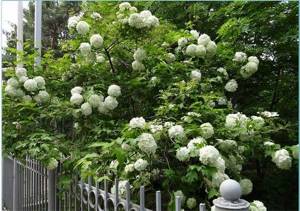
In the photo there is a bush Viburnum Buldenezh
Viburnum buldenezh (Viburnum "Boulede Neige" - snow globe) is a very picturesque species, it does not bear fruit. It is famous for its snow-white inflorescences of regular spherical shape, which abundantly cover the bush during flowering. The flower petals start out greenish in color, which when opened becomes bright white, and towards the end of the process a pinkish tint is added to it. The flowers are absolutely sterile; neither stamens nor pistils are observed in them.
The variety has high resistance to severe frosts and easily copes with drought and lack of sunlight. All these qualities make this species indispensable for decorating any garden.
Read more in detail Decorative viburnum Buldenezh
Viburnum Three-lobed

Viburnum triloba
Three-lobed viburnum (Viburnum trilobum Marsh) prefers moist forests and swamps for its habitat, and likes to grow on the banks of rivers in North America. It is a deciduous plant, its maximum height is 4-5 meters, and its diameter is 2.5-3.5 meters. The elegant flowering of this species of viburnum occurs at the very beginning of summer (May-June), when the bush is covered with large white umbrella inflorescences with a diameter of about 10 cm. With the onset of autumn, the leaves of the bush acquire a carmine-red hue, which looks extremely attractive. The berries are approximately 10 mm in size, regular spherical in shape, collected in clusters, and taste similar to black currants.
The plant is winter-hardy and is not susceptible to the harmful effects of insect pests, which allows for good harvests of berries. Loves light, as well as a sufficient amount of moisture. Successfully propagated by seeds or cuttings.
Kalina Raita
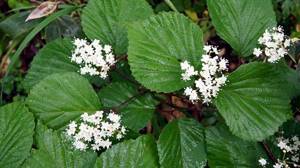
In the photo there is a Wright's viburnum bush
Viburnum wrightii (Viburnum wrightii Miq) is a dense, tall (up to 2.5 m) branched bush with a straight trunk, the crown diameter of which reaches 1 meter. This type of viburnum was listed in the Red Book of the Russian Federation and the Sakhalin Region in 2008. As a fruit plant, the selection of this type of viburnum began only in the middle of the 20th century, when it was discovered that the fruits are of high value, have high shelf life and good transportability, and are easy to collect.
The fruit-bearing bush has all the qualities that allow it to be used for landscaping. It blooms profusely in spring with fragrant inflorescences. The leaves are beautiful, bright green in summer and turn vibrant purple or yellow in fall. The berries are very juicy, have a bright red color, and a spherical shape.
In frosty winters, young shoots of Viburnum raita may freeze, and during dry summers it may get sick. It calmly tolerates even strong shade, but in a sunny place it demonstrates rapid growth and high fruiting. Reproduces by seeds, root shoots and shoots.
Viburnum Viburnum
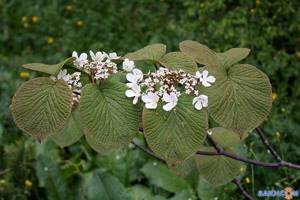
Viburnum fork
Viburnum fork (Viburnum furcatum Blume) is widespread on Sakhalin, the Kuril Islands, is found in Korea, Japan, prefers the slopes of mountains and hills, feels great in both coniferous and mixed forests. It is a deciduous shrub reaching a height of 4 meters. It is distinguished by forked branching and foliage, which has a dark greenish-yellow color in summer and spring, which in the fall amazes with its raspberry-lilac hue. The shape of the leaves is round-ovate. The flowers are white, arranged in umbrella-shaped inflorescences, their diameter is approximately 10 cm. The fruits are oblong, fleshy, at first their color is bright red, and later they become black, with a bluish tint.
A heat-loving species that places high demands on humidity, soil fertility, and can easily tolerate a lack of sunlight. It is propagated by seeds, shoots from stumps, and rooted by shoots. Viburnum fork has achieved enormous popularity in landscaping in Western Europe since the 19th century; in our country it is still rarely used.
Viburnum canadian
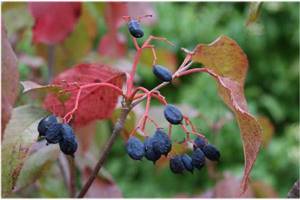
Viburnum canada in autumn
Canadian viburnum (Viburnum lentago) feels good on the slopes of mountains and hills, the banks of lakes, rivers, swamps, and forest edges. It can be a shrub or a slender tree, the height of which reaches six meters. The leaves are large and wide, oval in shape, slightly pointed; in summer their color is dark green, by autumn they acquire a reddish tint. Small white flowers with a cream tint are neatly collected in beautiful corymbose inflorescences. Blooms profusely and beautifully within 2 weeks. The berries are blue-black in color and are edible.
The growth of the shrub is very fast, it is shade-tolerant and highly frost-resistant. Canadian viburnum is unpretentious to the composition of the soil, but is very picky about its moisture. It can be propagated by cuttings, layering or seeds.
Canadian viburnum grows well in urban conditions, as it is not sensitive to gases. Thanks to the ease of care and planting, as well as their high decorative value, bushes of this type have become a favorite landscaping element for gardens, squares, and parks. The lifespan of the plant is approximately 80 years.
Viburnum folded

Viburnum folded
Viburnum plicatum (Viburnum plicatum) is an Asian relative of the common viburnum. This is an ornamental shrub with a height of 1.5 to 3 meters, the branches of which grow almost horizontally, forming a stepped crown consisting of separate layers. The foliage is very beautiful, has a grassy green tint. Flowering occurs at the very beginning of summer. Thanks to the peculiar arrangement of the inflorescences, when their white layers seem to alternate with layers of carved green leaves, the result is something like a layer cake. This creates an unforgettable spectacular spectacle. The bright red berries appear in August, then they will turn a rich black color and are unsuitable for food.

In the photo, folded viburnum in autumn
The Viburnum foliata shrub is a true fall beauty, with the foliage turning such vibrant shades of orange and yellow that it looks like it was painted by an artist with acrylic paints. The branches arranged in loose tiers illustrate the Japanese style in the landscape. Its light, weightless crown and bright colors are suitable for many design areas.
Common viburnum or red viburnum
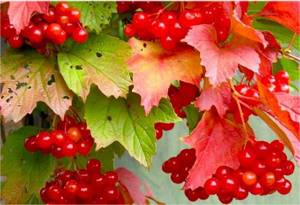
Red viburnum
Viburnum viburnum (Viburnum opulus) is the most common species in our country, which has long been used for decorative landscaping. It is a deciduous shrub or tree, up to 4 meters tall, with a crown diameter of approximately 3 meters. Flowering at the very beginning of summer. Large snow-white inflorescences cover the bush so densely that they can easily compete with the magnificent caps of tree-like hydrangeas. The plant becomes incredibly beautiful during the fruiting period, when it is dotted with clusters of unusually scarlet berries, filled with precious edible juice. It is recommended to pick berries immediately after the first frost, by which time their inherent bitterness and astringency will have significantly decreased.
Common viburnum is excellent for creating landscapes in a rustic style, for rural ensembles; it will decorate the landscape near a reservoir; it has proven itself excellent for ridges and hedges. The bushes have high frost resistance and are resistant to various pests and diseases.
Red viburnum is one of the most unpretentious plants. It can grow in different soils, in the sun and in the shade. True, growing in the shade, it does not bear fruit. In nature, you can most often find beautiful shrubs on the banks of any reservoirs, where they are provided with high soil moisture; they populate clearings and the edges of forests, deciduous and mixed. Large bright green leaves form carved frills, large white inflorescences up to 10 cm in diameter or more look elegant and attractive. Flowering occurs at the very end of May or beginning of June, depending on the weather. The berries are juicy, quite large, ripening begins at the end of August, they are suitable for use as food.
Red viburnum is grown, as a rule, for decorative purposes, but it has found application in medicine, homeopathy, and cooking. Viburnum bushes or trees look especially beautiful and appropriate against the background of various conifers or next to maples, weeping birches, and slender lindens. Bushes planted along the fence will create a picturesque hedge if they are regularly trimmed. The plant is highly frost-resistant and can withstand temperatures down to -35ºС.
Red viburnum beneficial medicinal properties
The fruits of red viburnum contain up to 32 percent invert sugar, 2 percent acids, up to three percent tannins, and ascorbic acid. The bitter taste of the berries is given by the glycoside viburnin, which has a therapeutic effect. Obviously, this is why selected forms of red viburnum with sweet fruits have less medicinal effect.
Red viburnum bark contains up to 6 percent resins, their composition includes various organic acids, tannins, flavonoids, vitamins C and K.
Preparations from red viburnum lower blood pressure, accelerate wound healing and have a hemostatic effect, improve heart function, and have a diuretic and choleretic effect.
Preparation of medicines
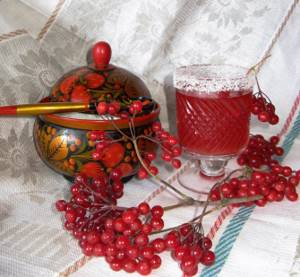
Based on viburnum, decoctions, infusions, tinctures and other products are prepared that enrich the body with vitamins and nutrients and support human health.
A decoction of viburnum berries - crush the berries in the amount of two tablespoons, pour a glass of boiling water and keep in a water bath for 20 minutes. After cooling, filter and take, adding sugar to taste. The drink has a general strengthening, anti-inflammatory and choleretic effect. It alleviates the condition of people who suffer from diseases of the heart, nervous system, hypertension, hysteria, and insomnia.
Viburnum tea - grind a tablespoon of berries and pour a glass of boiling water. Let it brew and take it warm (it can be sweetened if desired). The intake of this drink is not limited, it helps relieve symptoms of colds, flu, ARVI, and activates the body’s immune forces.
Alcohol tincture - into prepared berries in the amount of 1\2 kg. add two tablespoons of honey and 200 ml. alcohol or vodka. The container is closed and infused in a warm place protected from light for at least two weeks. The finished drink is filtered and taken in small portions to treat colds, infectious diseases, weak immunity, and insomnia.
Viburnum juice
The prepared berries are crushed in a meat grinder and the juice is squeezed out through cheesecloth, or you can pass it through a juicer. Consume with honey, diluting 1:1. The product treats hemorrhoids, stomach ulcers, colitis, and has a laxative effect. Normalizes cardiac activity, pulse, blood pressure, has an antispasmodic and analgesic effect.

The drink lowers cholesterol levels and prevents atherosclerosis
Viburnum with honey
Recipe: add chopped berries (two tablespoons) to half a liter of boiling water, leave for 20 minutes and strain. Take warm with the addition of honey (to taste and desire).
Beneficial properties: viburnum with honey is effective for diseases of the upper respiratory tract, bronchitis, chronic cough. The product has an anti-inflammatory, antiseptic and expectorant effect, helping to soften and remove thick, viscous mucus. Relieves cold symptoms, stimulates the body's protective functions.
Viburnum red application
The fruits and bark of red viburnum are used in medicine. The fruits of red viburnum are used in medicinal practice as a heart-soothing agent, a tonic, a vitamin and a mild diuretic. They are included in the vitamin collection. The fruits collected after frost are used to treat the initial stages of hypertension and cough. Extract and decoction of red viburnum bark are used for internal bleeding, as well as an antispasmodic and sedative in gynecology.
Viburnum juice is especially useful, it normalizes blood pressure, has a beneficial effect on stomach ulcers, coughs, liver and gallbladder diseases.
Viburnum fruits are widely used in home cooking. The fruits are canned, juices and jellies, jams, jellies, marmalades, pie fillings, and fruit drinks are prepared.
Contraindications to the use of red viburnum
The use of red viburnum is contraindicated for people with increased blood clotting and prone to the formation of blood clots. Its use is contraindicated for hypotensive people - people with low blood pressure. Use is contraindicated in case of increased acidity of gastric juice. It should not be used during pregnancy and breastfeeding.
Before use, consultation with a doctor is necessary.
If you have experience in using this plant, please do not be lazy and leave a comment on the article.

The shrub is grown everywhere, as it easily tolerates prolonged droughts and severe frosts. The fruits of viburnum are used not only for cooking, but also for medicinal purposes.
Health benefits and harms of viburnum
All parts of the plant are medicinal raw materials, have healing qualities and are used for the treatment and prevention of diseases.
Berries contain huge amounts of vitamin C, sugar, minerals, bioflavonoids and carotene. They have a diaphoretic and diuretic effect, relieve swelling of the heart and kidneys, enrich the body with vitamins and alleviate the symptoms of flu and colds.
The bark contains a lot of biologically active compounds - tannins, resin, saponins, phylloquinones, which improve blood clotting and help heal wounds.
Viburnum seeds are a plant antioxidant and have a cleansing effect on the body, ridding it of toxins and waste, and contain up to 20% fatty oil.
Viburnum for children
Eating fresh berries (just a few pieces) will provide the child with the daily requirement of vitamin C, which will help stimulate the immune system, cope with colds and viral infections, provitaminize the body, and relieve anemia. Viburnum and medicinal products from it will have a healing effect in diseases of the upper respiratory tract - bronchitis, pharyngitis, tracheitis. The plant will relieve increased nervous excitement, calm the child, and normalize sleep.
Viburnum for women
Viburnum fruits are good for women's health; the valeric acid contained in the berries will have a calming effect on the nervous system, relieve stress, fatigue, and alleviate the symptoms of menopause. The bark of the plant contains viburin, a substance that has vasoconstrictor properties, enhances the tone of the uterus and is used in solving gynecological problems.
For fibroids and severe uterine bleeding in women during menstruation, an infusion is prepared: a glass of bark is crushed and half a liter of alcohol or vodka is poured. Place in a dark place for 10 days to infuse. Then filter and consume a teaspoon with water before meals.
Make masks for facial skin care with fresh juice; viburnum has a rejuvenating effect, nourishes, whitens, cleanses, removes acne and freckles
Viburnum during pregnancy
During pregnancy, you should refrain from eating berries, as they contain plant hormones and their excess can provoke early birth or deviations in the health of the unborn child.
Viburnum for men
The plant will help a man maintain health, give him strength, relieve fatigue, and activate physical and mental abilities. It will have a preventive effect on the genitourinary system, relieve inflammation, reduce pain, and stimulate increased potency.
Where does common viburnum grow, the height of the bush, its flowers, berries and fruits (with photo)
The homeland of the shrub is Europe, Asia, Russia, North and Central America, North Africa. Common viburnum grows where a temperate climate prevails.
To begin with, we present to your attention a botanical description of the common viburnum: it is a perennial, deciduous, fast-growing shrub with gray-brown fissured bark. The height of the common viburnum is 2-3, less often the shrubs grow up to 5 m.
In spring it is decorated with white flowers, in autumn - with bright red clusters of fruits and purple-red leaves. The leaves are opposite, bare, broadly ovate, dark green in color, up to 5 - 10 cm long, with small stipules, reminiscent of maple leaves.
The flowers of Viburnum viburnum are white, fragrant, collected in corymbose magnificent inflorescences with a diameter of 12-15 cm, initially green, and then painted snow-white. Viburnum blooms profusely in early June.
The fruits are drupes, red or black and blue, edible, elliptical in shape, with red juice and yellow pulp, ripen in late August - September. The plant is winter-hardy and drought-resistant.
Look at the photos of red viburnum berries at different ripening periods:
About 200 species of viburnum are known. In addition to K. vulgaris, other species are also common - V. laptana, V. carlesii and V. tinus.
Fruiting of red viburnum (common) begins in the 6th year of life and reaches its peak by 12 years. The plant is shade-tolerant, relatively frost-resistant, prefers rich, moist soils. Propagated by seeds and cuttings.
The presence of this bush on your site will not only provide you with an excellent medicinal berry, but will also improve the landscape appearance of the garden. Viburnum, as a rule, is formed in gardens in the form of a small separate bush tree no more than 2.5–3 meters high. In nature, viburnum always chooses open and sunny places. It is not oppressed by winds. The lifespan of a viburnum bush in one place is up to 20 years or more.
In addition to the common viburnum with edible berries, there is also its purely decorative relative, the “Buldenezh” viburnum, which blooms with sterile white flowers collected in spherical large inflorescences. Naturally, “Buldenezh” does not produce berries and is not very decorative in the fall.
Both viburnums grow in partial shade, and the red one grows in the shade without any damage, and in the shade they are less attacked by pests than in the sun.
As can be seen in the photo, the common viburnum is highly decorative, looks great in group and single plantings and, above all, against the backdrop of green lawns, in hedges, and is also suitable as a ground cover plant:
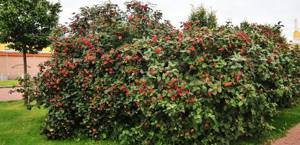
Viburnum is spectacular during flowering, fruit ripening, and also in autumn, when the leaves acquire a beautiful yellow and red color. In addition, viburnum is valued as a food and medicinal plant. The fruits of viburnum are used in medicinal practice as a means to calm the heartbeat; Warm decoction is drunk for colds.
Next, we present to your attention photos, names and descriptions of red viburnum varieties, the most popular among gardeners.
From bonsai to carpet
Very beautiful euonymus - sacred and winged - came to us from the Far East. These are small (up to 2 m tall), gnarled, slow-growing, highly branching shrubs. Relatively small leaves become intensely colored in bright reddish colors in autumn. The capsules are also small and usually few in number, light pinkish. The shrubs are shade-tolerant, but can grow well in open areas; they are drought-resistant and winter-hardy. In culture they are usually propagated by cuttings.
Among the euonymus there are low, groundcover species. We can recommend dwarf euonymus - an evergreen creeping shrub with small leathery leaves and rooting shoots. It is drought-resistant, winter-hardy, shade-tolerant, grows quite quickly, and is easily propagated by cuttings or layering.
Make friends with euonymus, and not only true aesthetic pleasure awaits you - after all, nature has not created an easier plant for us to cultivate!

| Popular varieties of Thunberg barberry | |
| Aurea | The diameter and height of the crown is about 1 m; with age it becomes spreading. In a well-lit area, the color of the foliage is lemon yellow; in partial shade, the yellowness gives way to a pleasant shade of lime. The leaves burn in the scorching sun. Autumn foliage color yellow-orange |
| Kobold | Miniature, bush height up to 0.5 m, diameter up to 0.8 m. In spring and summer, the leaves are shiny, emerald green, in autumn – yellow-orange |
| Helmond Pillar | Height 1–1.5 m, crown diameter up to 0.5 m. Young leaves are pink-red, then acquire a rich purple hue. Photophilous, leaves turn green in the shade |
| Erecta | Height up to 1.5 m, crown narrow, slightly falling apart in adult bushes. Leaves are yellowish-green in spring, yellow-red in autumn |
| Atropurpurea | The height and diameter of the bush is 2–3 m, the crown is medium dense. The leaves are purple-brown, carmine red in autumn. photophilous |
| Atropurpurea Nana | Height up to 0.6 m, diameter up to 1 m. The crown is compact, dense, shoots are erect. The leaves are small, purple, bright red in autumn. Photophilous, color fades in the shade |
| Rose Glow | The height and width of the bush is up to 1.5 m. The crown is well branched, the central shoots grow vertically, the lateral shoots deviate widely. The leaves on old shoots are purple, and on young shoots that appear in summer, there are white-pink and silver stripes and spots on a purple background. |
| Harlequin | The crown is spreading, 1.2–1.5 m in height and diameter. The leaves are burgundy with pink, white and gray spots. |
| Golden Ring | The height and diameter of the crown are 2–3 m. The shoots droop with age. Leaves are purple with a narrow yellow border |
The materials were prepared by landscape designer Marina Bakusheva, candidate of biological sciences Evgeniy Klyuykov, doctor of agricultural sciences. Sciences Elena Malankina, Candidate of Biological Sciences Irina Okuneva, Candidate of Agricultural Sciences Science Olga Chemarina
Methods for propagating viburnum by cuttings and suckers (with video)
The main methods of propagating viburnum are by seeds, green and lignified cuttings, rooted layering and shoots. When propagating by lignified cuttings, cuttings are taken in the spring from annual shoots. Cuttings taken from the upper half of the shoots take root better.
Green cuttings, which are harvested in early June, during the period of increased shoot growth, also take root well. Cuttings are cut in the morning, when the shoots are well watered. Well-developed shoots located on the southern and southwestern side of the bush are better suited for propagation of viburnum and give a high percentage of rooting. Cut shoots are divided into cuttings and placed in a heteroauxin solution for 12–20 hours. When planting, the cutting is planted vertically in a box, burying the lower end into the soil by 2–3 cm. By squeezing it around the cutting, the soil is somewhat compacted. When propagating viburnum, cuttings are planted according to a 6x8 cm pattern, but in any case, so that their leaves do not touch each other. Leaves should also not touch the soil. Arcs 15–20 cm high made of wire are placed on the box and covered with plastic film. High air humidity is created under the film, which promotes rooting of cuttings. Before rooting, the cuttings are sprayed with water from a spray bottle 4-5 times a day. It is desirable that there is dew on the leaves. Good lighting is an essential condition for successful rooting, but at the same time, cuttings must be protected from direct sunlight. After the roots have formed, the film begins to be opened, first for a short time, then increasingly increasing the duration - it is hardened. By autumn they take root well and some of them become full-fledged seedlings for planting in a permanent place. The weaker ones are sent to school for growing up.
This video shows the propagation of viburnum by cuttings until complete rooting:
Reproduction of viburnum is also carried out by bite shoots. A separate shoot with independently formed roots is dug up in the fall of the year of germination or in the spring of the next year and planted in a previously prepared planting hole.
Growing red viburnum: planting and care (with photo)
When growing and caring for, viburnum is not demanding on the soil, but, naturally, it grows better in fertile, slightly acidic soil. Shrubs do not need watering or fertilizing if you do not remove fallen leaves from under them. But, alas, viburnum needs protection from pests. Who doesn't attack her? Therefore, in the spring, as soon as the leaves begin to unfurl, viburnum should be sprayed with any anti-pest preparation. Usually used for spraying with karbofos, Fufanon or Healthy Garden. Moreover, spraying alone is not enough; you will have to repeat it just before flowering, then 2-3 weeks after flowering (red spray on young ovaries and again after coloring the berries).
It is best to plant common viburnum, like all shrubs, in August–September, but you can also plant it in early May, before the leaves have yet unfurled. The plant is quite frost-resistant, so it does not need shelter; it can be planted on the north side of the site or buildings, that is, in a place where practically no other plants can be planted. The berries are stored well in bunches in the freezer of the refrigerator. Wild viburnum berries from the forest have a mediocre taste, but hybrid varieties of viburnum have large and tasty berries. The most famous varieties are “Taiga Ruby” and “Maria” (a variety in memory of the famous breeder Maria Nikolaevna Plekhanova).
Under natural conditions, viburnum grows under the forest canopy, so it tolerates partial shade in gardens. Viburnum has high winter hardiness; it is not afraid of frosts down to –35–40 degrees. In recent years, it has been successfully introduced into amateur gardens, where its yields reach 15–20 kg per bush. It is unpretentious and undemanding to growing conditions, but, like any plant, it produces higher yields on fertile soils. With good moisture, the fruits are larger and juicier. Ripe fruits are juicy and bitter in taste. The bitterness decreases greatly when the viburnum is “grabbed” by winter frost. After the onset of stable winter frosts, they are collected in tassels and stored fresh frozen.
Viburnum common - description
The height of viburnum bushes reaches two to four meters.

The main time for this shrub is from spring to late autumn.
Viburnum common or otherwise “red” is a deciduous shrub whose height is two meters. There are individuals that grow up to four meters in height.
The peak of the plant's beauty occurs from late spring to mid-autumn.
Viburnum flowering and fruiting
Flowering of viburnum begins in mid-May and continues until the end of June.
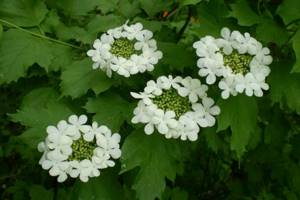
In the center of the thyroid inflorescences of viburnum you can see small trumpet-like flowers - these are future berries.
For your information. Do not forget that the inflorescences of the bush are excellent honey bearers that attract abundant pollinating insects.
Closer to autumn, the fruits of viburnum actively ripen , but it is recommended to collect them around the second week of September. Harvesting at this time guarantees juicy, bright red berries.
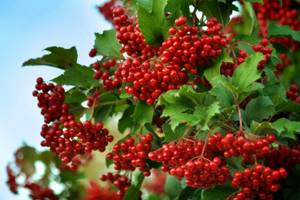
Through the translucent juice inside the berry you can see the flattened seed. Large clumps of ruby viburnum hang from the bushes until early winter. Like the red-breasted bullfinch, the bright scarlet berries of the viburnum decorate the faded pre-winter landscapes.
The variety of viburnum gives you the opportunity to choose. Some people like the wild variety, growing near swamps, forest clearings, at the foot of hills and along the perimeter of rivers. Many people bring seedlings of wild viburnum from the forest to their site, where it subsequently grows on its own.

However, people engaged in cultivating their land holdings prefer more “garden” viburnum, such as Roseum.
The most famous of the later developed varieties of viburnum are “Uralskaya sweet”, “Sverdlovskaya semi-sweet”, common viburnum “Kompaktum” and “Altai”.
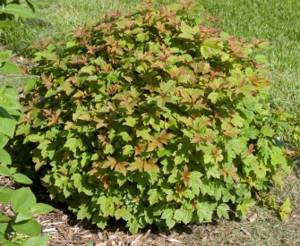
These varieties produce up to 30 kilograms of large berries, which are great for boiling or freezing.
Interesting. It is worth noting that sometimes it is difficult to distinguish wild viburnum from viburnum purchased in a store. Varieties from the forest take root well and grow into no less lush and flowering shrubs than their neighbors from the nursery. In autumn, juicy large fruits are harvested from both species.
Description of Viburnum Roseum
In addition to the common red viburnum, people are very fond of another variety - the common viburnum Roseum.
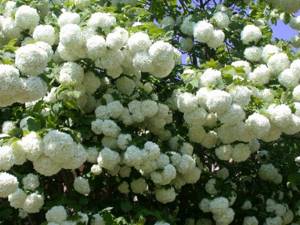
Most people call it Viburnum buldenezh with its characteristic milky-white spherical handfuls of flowers.
The ancient variety of viburnum Roseum is considered the most beautiful variety. It is also called terry.
Snow-white, terry, delicate inflorescences in a rounded shape look truly noble and add freshness, diluting their neighbors on the plot of land.

For your information. One of the most practical solutions for planting viburnum bushes is the creation of a hedge. Planted in a single line, the plant creates a blank fence that fits colorfully into the landscape. Such hedges perfectly cover sheds or other outbuildings on the site.
Pests and diseases of red viburnum
Special attention should be paid to measures to protect red viburnum from diseases and pests. The most dangerous pests are aphids and viburnum leaf beetles. Hordes of aphids will instantly attack the bush throughout the summer, especially in humid, warm weather between the end of May and mid-June. Aphids inhabit not so much the young growths of twigs as the clusters of flower umbels. They are literally black with aphids. To combat aphids, herbal preparations commonly used against other types of aphids are used, such as infusion of dandelion, horse sorrel, potato or tomato tops. The same drugs also suppress the development of young larvae of the viburnum leaf beetle. But adult leaf beetle larvae and beetles are very tenacious, and to destroy them it is necessary to spray with chemicals: karbofos, INTA-VIR, Decis, Fury. The dosages and methods of use of these drugs are indicated on the packages or in the accompanying instructions.
And in the fall, immediately after the leaves fall, spray the bush with Bordeaux mixture. In early spring, while there is still snow, carefully examine the viburnum bushes. A chain of protuberances can be seen at the tops of the branches. They are slightly darker than the bark and covered with a sort of fluff. These are the eggs of the viburnum leaf beetle. It is necessary to cut off these tops and burn them. Otherwise, in the spring, tiny larvae will hatch from them, which will leave only veins of the leaves, causing far from tiny damage to the entire tree.
The leaves of the viburnum are damaged by the pest the leaf beetle, the young shoots are damaged by the black viburnum aphid, and the flowers are damaged by the viburnum gall midge. Leaf pests are controlled by spraying before and after flowering, and, if necessary, again after 10–12 days. The most effective drug "Iskra DE": 1 tablet (10 g) per 10 liters of water with the addition of 1 tbsp. spoons of tar soap. Tobacco, onion and garlic infusions are also used. No diseases were observed on viburnum.
You can treat with an infusion of wood ash: 1 kg of wood ash is poured into 5 liters of water, add 1 tbsp. a spoonful of liquid soap (tar or laundry soap) and leave for two days, then filter and spray the plants. An infusion of tobacco is also used: 0.5 kg of tobacco or shag is poured with boiling water and left for 24 hours, add 1 tbsp. a spoonful of mustard, ground pepper and liquid soap, filter and spray the bushes.

